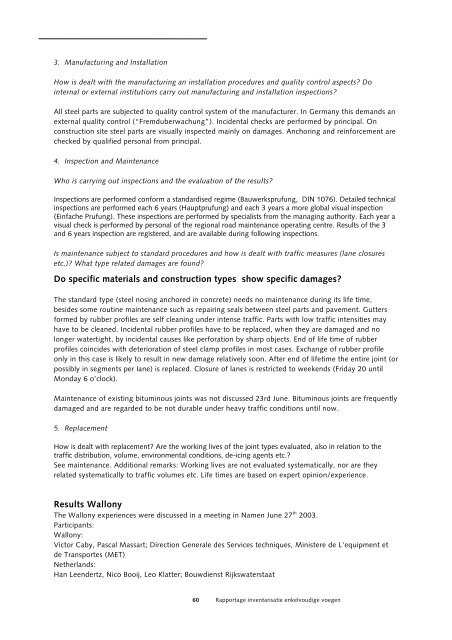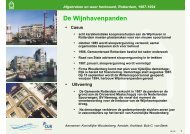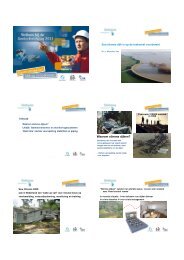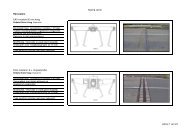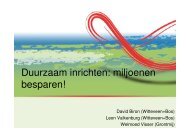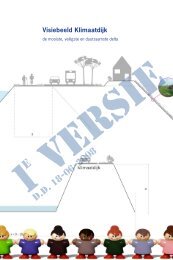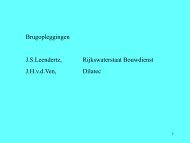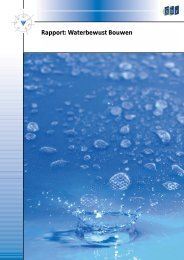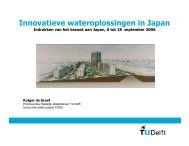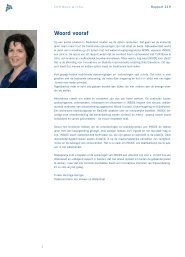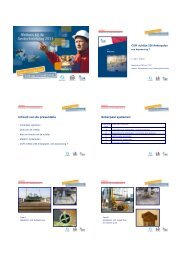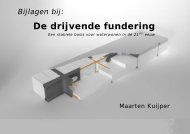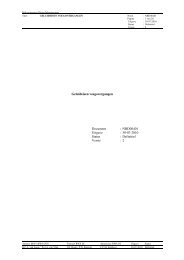Rapportage inventarisatie enkelvoudige voegen - Curnet
Rapportage inventarisatie enkelvoudige voegen - Curnet
Rapportage inventarisatie enkelvoudige voegen - Curnet
Create successful ePaper yourself
Turn your PDF publications into a flip-book with our unique Google optimized e-Paper software.
3. Manufacturing and Installation<br />
How is dealt with the manufacturing an installation procedures and quality control aspects? Do<br />
internal or external institutions carry out manufacturing and installation inspections?<br />
All steel parts are subjected to quality control system of the manufacturer. In Germany this demands an<br />
external quality control (“Fremduberwachung”). Incidental checks are performed by principal. On<br />
construction site steel parts are visually inspected mainly on damages. Anchoring and reinforcement are<br />
checked by qualified personal from principal.<br />
4. Inspection and Maintenance<br />
Who is carrying out inspections and the evaluation of the results?<br />
Inspections are performed conform a standardised regime (Bauwerksprufung, DIN 1076). Detailed technical<br />
inspections are performed each 6 years (Hauptprufung) and each 3 years a more global visual inspection<br />
(Einfache Prufung). These inspections are performed by specialists from the managing authority. Each year a<br />
visual check is performed by personal of the regional road maintenance operating centre. Results of the 3<br />
and 6 years inspection are registered, and are available during following inspections.<br />
Is maintenance subject to standard procedures and how is dealt with traffic measures (lane closures<br />
etc.)? What type related damages are found?<br />
Do specific materials and construction types show specific damages?<br />
The standard type (steel nosing anchored in concrete) needs no maintenance during its life time,<br />
besides some routine maintenance such as repairing seals between steel parts and pavement. Gutters<br />
formed by rubber profiles are self cleaning under intense traffic. Parts with low traffic intensities may<br />
have to be cleaned. Incidental rubber profiles have to be replaced, when they are damaged and no<br />
longer watertight, by incidental causes like perforation by sharp objects. End of life time of rubber<br />
profiles coincides with deterioration of steel clamp profiles in most cases. Exchange of rubber profile<br />
only in this case is likely to result in new damage relatively soon. After end of lifetime the entire joint (or<br />
possibly in segments per lane) is replaced. Closure of lanes is restricted to weekends (Friday 20 until<br />
Monday 6 o’clock).<br />
Maintenance of existing bituminous joints was not discussed 23rd June. Bituminous joints are frequently<br />
damaged and are regarded to be not durable under heavy traffic conditions until now.<br />
5. Replacement<br />
How is dealt with replacement? Are the working lives of the joint types evaluated, also in relation to the<br />
traffic distribution, volume, environmental conditions, de-icing agents etc.?<br />
See maintenance. Additional remarks: Working lives are not evaluated systematically, nor are they<br />
related systematically to traffic volumes etc. Life times are based on expert opinion/experience.<br />
Results Wallony<br />
The Wallony experiences were discussed in a meeting in Namen June 27 th 2003.<br />
Participants:<br />
Wallony:<br />
Victor Caby, Pascal Massart; Direction Generale des Services techniques, Ministere de L’equipment et<br />
de Transportes (MET)<br />
Netherlands:<br />
Han Leendertz, Nico Booij, Leo Klatter; Bouwdienst Rijkswaterstaat<br />
60 <strong>Rapportage</strong> <strong>inventarisatie</strong> <strong>enkelvoudige</strong> <strong>voegen</strong>


